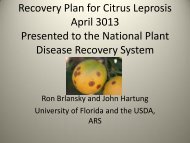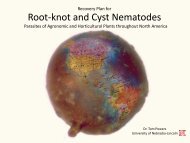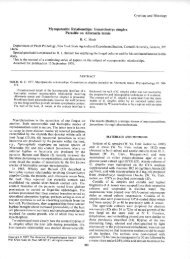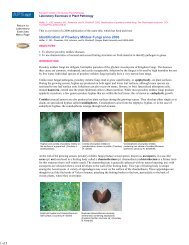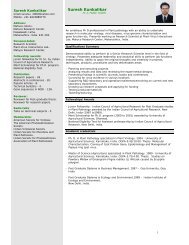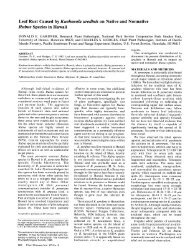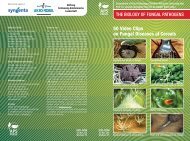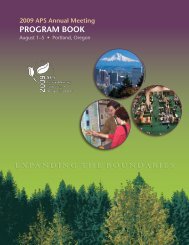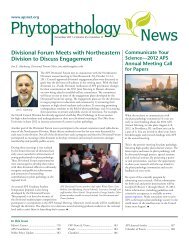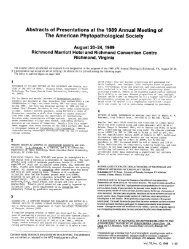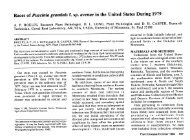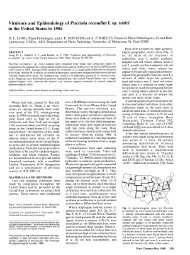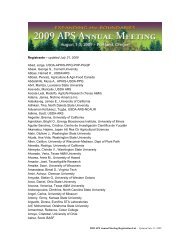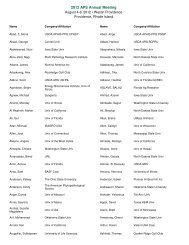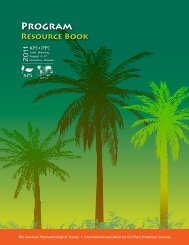See the program book (PDF) - American Phytopathological Society
See the program book (PDF) - American Phytopathological Society
See the program book (PDF) - American Phytopathological Society
You also want an ePaper? Increase the reach of your titles
YUMPU automatically turns print PDFs into web optimized ePapers that Google loves.
spp. in soil of a hardwood forest in <strong>the</strong> sou<strong>the</strong>rn<br />
Appalachian Mountains. I. M. MCLAUGHLIN<br />
(1), S. N. Jeffers (1), T. A. Waldrop (2). (1)<br />
Clemson University, Clemson, SC, U.S.A., (2)<br />
U.S. Forest Service, Sou<strong>the</strong>rn Research Station,<br />
Clemson, SC, U.S.A.<br />
10:30 a.m. O-162. Fungal pathogens (mis-) identification:<br />
A case study with DNA barcodes on Melampsora<br />
rusts of white and aspen poplars. N. Feau (2),<br />
M. Allaire (2), A. VIALLE (3), P. Tanguay (2),<br />
D. L. Joly (3), P. Frey (1), R. C. Hamelin (2). (1)<br />
Institut National de la Recherche Agronomique,<br />
Centre de Recherches de Nancy, Champenoux,<br />
France, (2) Laurentian Forestry Centre, Canadian<br />
Forest Service, Natural Resources Canada, Sainte-<br />
Foy, QC, Canada, (3) Universite Laval, Quebec,<br />
QC, Canada<br />
10:45 a.m. O-163. Diseases of introduced Eucalyptus and<br />
native Myrtaceae in Uruguay: New cases of host<br />
jumping. C. A. PEREZ (1), M. J. Wingfield<br />
(2), B. Slippers (2), N. A. Altier (3), S. Simeto<br />
(3), R. A. Blanchette (1). (1) Department of<br />
Plant Pathology, University of Minnesota, St.<br />
Paul, MN, U.S.A., (2) Forestry and Agricultural<br />
Biotechnology Institute (FABI), University of<br />
Pretoria, Pretoria, South Africa, (3) Instituto<br />
Nacional de Investigación Agropecuaria (INIA),<br />
Canelones, Uruguay<br />
11:00 a.m. O-164. Ecophysiological factors mitigating in<br />
planta survival of P. ramorum in California bay<br />
laurel. M. V. DILEO (1), R. M. Bostock (1), D.<br />
M. Rizzo (1). (1) UC Davis, Department of Plant<br />
Pathology, U.S.A.<br />
11:15 a.m. O-165. Linking models of resource-based<br />
tradeoffs in trees: An assessment of growth,<br />
defense, carbon allocation patterns, and potential<br />
ectomycorrhizal regulation in paper birch. N. M.<br />
KLECZEWSKI (1), P. Bonello (1). (1) The Ohio<br />
State University, U.S.A.<br />
Molecular Detection & Characterization<br />
9:00 – 10:15 a.m. * 200 FG<br />
Section: Molecular / Cellular Plant–Microbe Interactions<br />
Moderator: Rio Stamler, New Mexico State University, Las<br />
Cruces, NM<br />
9:00 a.m. O-166. A real-time PCR assay for <strong>the</strong> detection of<br />
Pasteuria nishizawae in soil. N. ATIBALENTJA<br />
(2), M. Babadoost (2), G. R. Noel (1). (1)<br />
USDA-ARS, Urbana, IL, U.S.A., (2) University<br />
of Illinois, Urbana, IL, U.S.A.<br />
9:15 a.m. O-167. Genetic characterization of Acidovorax<br />
avenae subsp. citrulli using amplified fragment<br />
length polymorphism (AFLP). A. WEN (2), A.<br />
Mangravita-Novo (1), D. L. Hopkins (1), D. J.<br />
Norman (1). (1) Univ. Florida, Mid-Florida REC,<br />
Apopka, FL U.S.A., (2) Univ. Florida, North<br />
Florida REC, Quincy, FL U.S.A.<br />
“It is our opinion that an<br />
<strong>American</strong> <strong>Phytopathological</strong><br />
<strong>Society</strong> placed upon a broad and<br />
generous foundation, may be<br />
of invaluable aid in promoting<br />
<strong>the</strong> future development of this<br />
important and rapidly growing<br />
subject in America, and that<br />
its influence may be made<br />
of international importance.”<br />
– Founding Members of APS<br />
Continuing <strong>the</strong> ApS legacy!<br />
Embracing this vision of <strong>the</strong> APS<br />
founders, <strong>the</strong> last century of APS<br />
members have left an invaluable legacy.<br />
As active APS members you contribute<br />
to <strong>the</strong> continuation of this legacy. APS<br />
would not be what it is today without<br />
<strong>the</strong> contributions of its membership.<br />
The ideas, time and expertise provided<br />
by APS members have shaped this<br />
organization into what it is today.<br />
Sincere thanks to all members for <strong>the</strong>ir<br />
contributions to APS and <strong>the</strong> science of<br />
plant pathology!<br />
63<br />
WeDneSDAy



